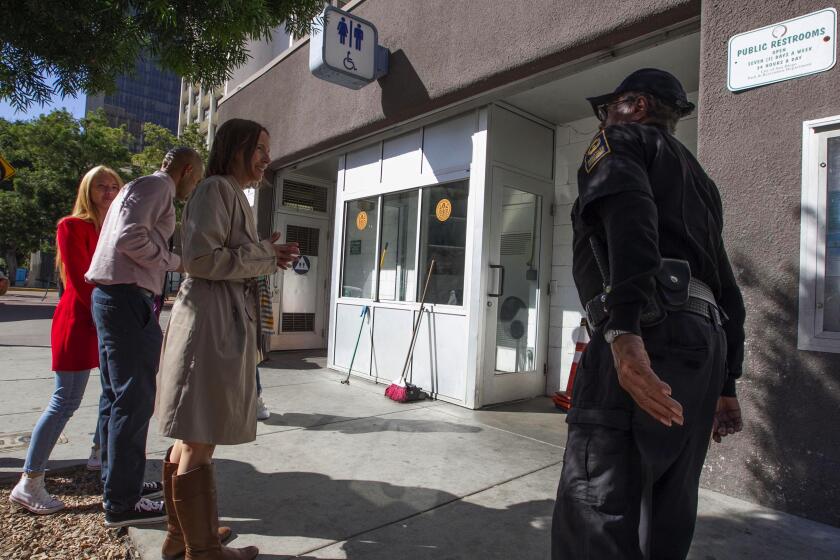Tourists came to San Diego for Metallica, left with hepatitis A

Three friends from Salt Lake City visited San Diego in early August for the Metallica concert at Petco Park. Two of them unknowingly brought home a souvenir: hepatitis A.
Three friends from Salt Lake City visited San Diego in early August for the Metallica concert at Petco Park. Two of them unknowingly brought home an unwelcome souvenir.
Mike Johnson, 43, was diagnosed with hepatitis A on Sept. 14, a little more than a month after his trip to San Diego. By that time, his eyes and skin had turned a shade of yellow and doctors told him he was nearing liver failure.
“It was a nightmare. I was sleeping 14 to 16 hours a night,” Johnson said. “I couldn’t walk more than 100 feet without getting tired.”
Johnson’s friend, Josh Oviatt, 44, spent four days in the hospital.
“It was a phenomenal weekend, but we’re paying for it now,” Johnson said. “I essentially sacrificed six months of my life for that one weekend of fun.”
The third friend, Mike Rinna, 51, had previously been vaccinated for hepatitis A and did not get sick.
The San Diego outbreak has killed 20 people and more than 370 have required hospitalization. As of Tuesday, the county has tallied 544 people infected, and new cases continue to crop up. It’s one of the worst outbreaks the nation has seen in decades.
Johnson and Oviatt are unusual cases. Homeless individuals and illicit drug users represent the majority of cases and are considered most at-risk, according to county health officials. The virus is being spread from feces to mouth so unsanitary conditions — particularly among the region’s growing homeless population — make it more likely to spread.
It’s rare for the public to know anything about those who have contracted the disease. Health officials have been hesitant to release specifics on where cases are concentrated and who has been exposed, citing state and federal health privacy laws.
The weekend of the concert, Johnson said he and his friends “had a ball,” riding bikes on the Pacific Beach boardwalk, swimming in a hotel pool downtown, and eating and drinking at local bars and restaurants.
Johnson said he contacted U-T Watchdog because of one restaurant in particular.
All three men ate and drank at World Famous, the Pacific Beach eatery that was the subject of a September warning from county officials about possible hepatitis A exposure.
On Sept. 15 the county warned members of the public that they might be in danger of exposure if they went to World Famous at certain dates and times:
- Aug. 28, 29 and 30 from 3 p.m. to 11 p.m.
- Sept.3 and 4 from 9 a.m. to 6 p.m.
- Sept. 10 and 11 from 3 p.m. to 11 p.m.
A U-T Watchdog investigation into the restaurant’s inspection history revealed that it had repeatedly violated California food laws. County inspection records show World Famous was cited with seven violations under the California Retail Food Code on Sept. 8, a week before the hepatitis A announcement.
Restaurant managers said the inspection issues were an unfortunate coincidence and had nothing to do with the hepatitis A situation. They also said the health issues had been addressed and corrected.
County spokesman Michael Workman said officials are aware of several cases in Utah, including Johnson and Oviatt.
The possible exposure window at World Famous was not in effect when Johnson, Oviatt and Rinna visited the restaurant, Workman said.
“We are certain they did not contract hepatitis A from our known case [at World Famous],” Workman said. “More likely culprits would be publicly-shared bathrooms on or off property, another unknown infected person, or any contaminated surface in or around the establishment.”
According to the Centers for Disease Control and Prevention, nearly 40 percent of those who contract hepatitis A require hospitalization, but it’s rare for someone to die from the disease. Death is more common among individuals who are over the age of 50 or have underlying liver problems.
Johnson said he did not know about the outbreak until he and Oviatt started getting sick in early September.
Symptoms include fever, fatigue, nausea, loss of appetite, yellowing of the eyes, stomach pain and vomiting. The usual time period from exposure to showing symptoms is 15 to 50 days, which means Johnson and Oviatt were most likely infected while visiting San Diego.
Johnson said he and his friends sat at the bar at World Famous on August 6, the day of the Metallica concert. They ordered beer, water and some appetizers, all of which were served by the bartender.
They also ate at several other restaurants and spent time at the beach.
According to county health officials, at least 17 food-service workers have been infected so far. Besides the case at World Famous, the county has not notified the public of food service worker infections. Officials say the other cases were not publicized because the infection was not identified in time for exposed members of the public to protect themselves with a vaccine.
Watchdog Videos


Public water district charges customer for legal work, response to records request

Video: Tiny homes won't be reused amid housing, homeless crisis

Attorney General seeks documentation for Miss Middle East

Rep. Hunter probe covers possible fraud

Video: SDG&E delaying solar credit for some low-income housing tenants






